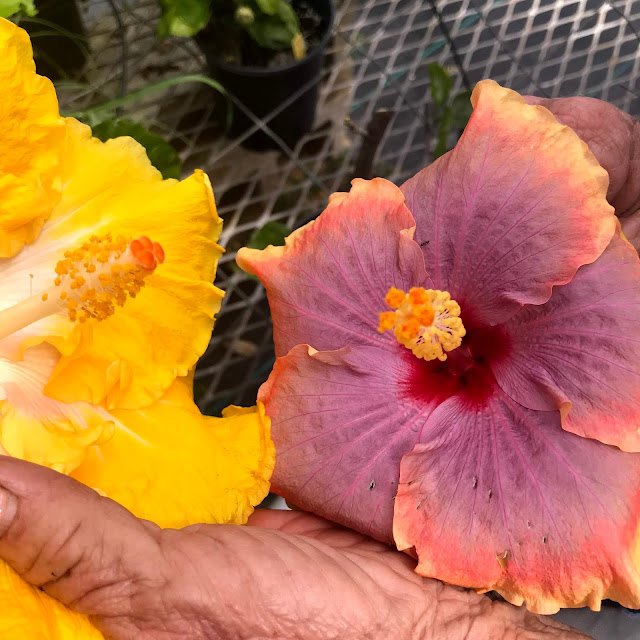In mid-December I had a nūnī (new knee) installed by the extremely competent and able Dr Harpstrite, operating at Queenʻs. Then I was off to the Rehabilitation Hospital of the Pacific on Kuakini Street, near the mouth of the valley of Nuʻuanu. Spent 12 days there, learning how to walk adequately, climb (and descend) stairs, bathe, etc., before coming home. I live solo in a home with stairs, so practice was needed so I could live more or less independently. Dear family and friends brought groceries and drove me to physical therapy sessions in Hilo. Appreciations and gratitudes abound.
Mid-January to mid-February the bending of nūnī did not improve. It wouldnʻt go past 80 degrees, despite exercises and exhortations. Turns out I have a LOT of scar tissue in there, and nūnī needed to undergo an MUA (Manipulation Under Anesthesia). Bending by Dr Harpstrite while I was asleep. He says it sounded like so much Rice Krispies and some gravel as scar tissue tore. You can imagine. Now, on a good day, I "holo i mua me ka MUA" [go forward with (because of) the MUA], and nūnī can bend to 120 degrees, with lots of clicking and other odd sounds. Seems to be working well, as it should, for the close to $55K price tag. So, so, very happy I listened to Ma, and retired with medical insurance...rather than quitting in a fit of pique... Iʻve had to pay 1% of the bill...
In short, thatʻs what Iʻve been up to...
So. Back to those hibiscuses... Iʻm a sucker for color, and really appreciate the multiplicity of shades of hybrid flowers. Some, of course, are more favored than others, but the fact and possibilities of helping create new versions can bewilder.
We have endemic (only found naturally in Hawaiʻi) hibiscuses. A specific one, maʻo hau hele (Hibiscus brackenridgei), is our State flower. The photo below is by weedmandan, found on Flickr.
Note the stubby curved pistil. Petals are delicate and fragile, and leaves beautifully lobed. Maʻo hau hele is one of our brightest endemic blooms, and very useful in making dye for kapa. According to Jill Coryell, who I mentioned yesterday, maʻo hau hele is genetically different than other hibiscuses, and so isnʻt used (by her) for hybridization. Iʻll follow up and report back about this issue.
Some Basic Botany from Sciencestein Secondary School Science:
Try to be concise, Robert... As above... Anthers carry pollen. In little sacks. The anther, when mature, pops open, allowing pollen grains to land on sticky stigmas. A pollen tube grows down the style, eventually reaching the ovary, where eggs are fertilized by the pollen.
In hibiscuses, anthers open a few hours after the flower blooms, allowing the hybridizer a window of opportunity to manually cross-pollinate two different flowers, rather than letting nature take its course and letting pollination happen naturally. Sure hope this makes sense...
Not to confuse you, but below is a cross-section of a lily. Same parts, different arrangement.
Now. Below is the pistil of a hibiscus from FierySunset on DeviantArt. Note that the top-most anthers have popped open, with pollen grains visible.
And another found on Flickr by RayinManila, where all the anthers are open:
But the coolest, I think, is below: an individual anther with spiky pollen grains.
Meanwhile, at Jillʻs in Mokulēʻia... I neglected to get names for most of her hybrids... but below is the bright yellow pollen donor:
Mating completed, below you can, I hope, see yellow pollen grains stuck to the sticky orange stigma of the purple flower.
Then...wait several months for seeds to develop and ripen, plant them, and if youʻre lucky, in a year and a half, flowers will bloom. Jill says she deems maybe 3% of plants from each cross worthy of propagating.
Some pretties follow...
and this last is, according to Jill, "Hae Hawaiʻi", the Hawaiian flag hibiscus. Her version is that this flower originated in Australia, and was brought to Hawaiʻi in the late 1800ʻs. It was cultivated as part of annexation protests, much like Hae Hawaiʻi quilts were sewn during that time.
Ending with an impromptu assembly, starring Halemaʻumaʻu Beauty:
I trust that this has been a worthwhile diversion, if only for the brilliant colors. Comments, as always, are welcome...
And yes, especially now,
be outside...pay attention noho i waho...a maliu
As always, with aloha,
BobbyC
maniniowali@gmail.com
















Beautiful and informative - thank you.
ReplyDelete